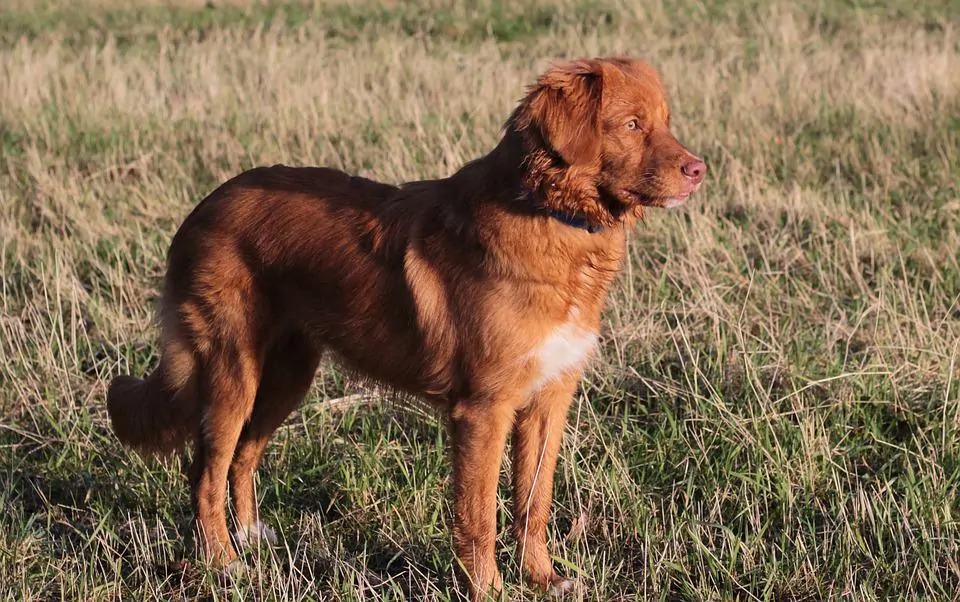Don’t let the extra-long name put you off these adorable micro-retrievers. The Nova Scotia duck toller is a fun, affectionate breed with the intelligence and drive you would expect from any gundog and the energy level to surpass even an adolescent labrador’s.
They are an immensely fun dog to own, but only if you have the time to tire them out both mentally and physically.
Keep reading to find out if this little red fox dog would be a good fit for you.
Contents
General Characteristics of the Nova Scotia Duck Tolling Retriever
- Other names: Yarmouth Toller, Little Red Duck Dog
- Height: 17 to 21 inches
- Weight: 35 to 50 pounds
- Lifespan: 12 to 14 years
- Origin: Nova Scotia, Canada
- Colors: Golden-red to deep copper with or without white markings on the chest, feet, and tail.
- Activity level: Medium to high
- Grooming needs: Low to medium
- Best suited for: Active individuals and families and fowl hunters
The handsome toller has a unique red coat, yellow eyes, and a personality that is hard not to love.
The History of the Nova Scotia Duck Tolling Retriever
There isn’t a lot of hard evidence as to what dogs went into creating the toller, but that hasn’t stopped many breed experts from trying to put the puzzle together.
The Nova Scotia toller was developed in Yarmouth County in Nova Scotia around the beginning of the 1800s. At the time, the Micmac Indians of the area were known to use small, red pariah dogs to lure ducks toward the shore where they could be shot or caught. In order to create their own breed of tolling dog, the locals started breeding the perfect compact retriever.
Spaniels, setters, retrievers, and possibly even some collie-like farm dogs likely went into the creation of this Nova Scotia dog. The smaller spaniels helped make a retriever significantly smaller than the local labs and Chesapeeks while the setter blood likely helped bring out the red coat.
The coloring of this dog was especially important given their intended use. The NSDTR, like the red pariah dogs before it, needed to resemble foxes.
When ducks and other fowl spot foxes moving to and away from the shoreline, they instinctively go to investigate, likely as a means to keep the stalking predator within their sight. By mimicking this odd behavior of moving toward and away from the water, the red tollers have the same effect on waterfowl.
With a water repellent coat, passion for swimming, and obsession with fetching, the toller was crafted to be the perfect fowl hunter’s companion.
Hunters used this “tolling” technique to bring fowl within reach. Once the birds are close, the hunter calls the Nova Scotia toller back and steps out of the blind, causing the birds to take to the sky where they can shoot them down.
The toller then dives into the water to retrieve the downed birds.
Today, this Nova Scotia dog is still frequently used as a hunter’s helper but is more often kept as a companion animal.
The Temperament of the Nova Scotia Duck Tolling Retriever
Like all retrievers, the Nova Scotia toller is full of energy, driven to chase flying objects, and affectionate and sweet with family and friends. But even more so than most retrievers, this dog has energy.
Wearing a toller out physically requires a lot of fetch or frequent, brisk walks. But getting them mentally tired is the true challenge.
These dogs enjoy solving puzzles and are happiest when they have a job to do. They are well-suited for agility, dock diving, and other dog sports. Their smaller size combined with their high intelligence and drive also makes them great choices for search and rescue.
Like German shorthaired pointers, cattle dogs, and other high-drive dogs, the toller needs a job to do. Failing to give them one can lead to destructive and unwanted behaviors.
At home, the toller is good with kids and happiest when allowed to hang out with the family, whether in the backyard or on a long mountain hike.
They enjoy the water and their thick, double-coat, keeps them dry in any situation, making them great candidates for life in harsher climates.
The duck tolling dog is eager to learn but can be stubborn if they don’t like the rules of the game or don’t feel there is anything in it for them. They respond best to positive training but need set boundaries or else they will walk all over you.
Overall, this is a sweet dog with typical retriever-like qualities plus an added touch of energy and curiosity.
Health Issues Common to the Nova Scotia Duck Tolling Retriever Breed
The toller population is relatively small compared to many dog breeds and their genetic population is even smaller. This combination means it is not uncommon for closely related dogs to be bred together. Over the last century, this has led to many health issues within the breed that prospective owners should be aware of.
Here are the most common health ailments in the NSDTR:
- Immune issues such as rheumatoid arthritis and thyroiditis
- Eye issues like progressive retinal atrophy and collie eye anomaly
- Hip dysplasia
- Addison’s disease
- Aseptic meningitis
- Cleft palate
Duck tolling dogs are cute from the moment they are born, which makes them hard dogs to resist. To make sure you get to enjoy that cuteness for years to come, you’ll want to research your breeder carefully and make sure they are taking all the necessary steps to ensure healthy puppies.
In an attempt to rid the breed of such health ailments and to keep a higher degree of heterozygosity, many duck tolling retriever breed clubs are focusing more on responsible breeding practices and in-depth health testing for breeding dogs.
Any dog that is being considered for breeding should undergo a hip and eye evaluation, a cardiac exam, and DNA screening for progressive retinal atrophy and juvenile Addison’s disease.
By performing this myriad of tests on all breeding dogs and carefully choosing mating pairs, the duck tolling retriever community hopes they can bring back some genetic diversity to the breed.
Because the exact mix of breeds that went into creating this dog is not known, attempts to outbreed for genetic diversity have not been widely discussed. Doing so could easily change the look and instinct of the duck tolling dog. However, if current population trends continue, there may be no other option for preserving the fortitude of the breed.
Do Nova Scotia Duck Tolling Retrievers Do Well With Children and Other Pets?
Like most retrievers, the Nova Scotia toller adores children. They are affectionate and gentle with kids of all ages. Older kids provide a great way to tire out the tireless breed and provide the companionship these dogs crave.
Like any breed, each individual’s temperament is a combination of their genes and experience early in life. Introducing duck tolling retriever puppies to children and babies early on will help guarantee they will do well with kids as adults.
Puppies who are raised around young children tend to do better with them as an adult. Still, it is rare to find a duck tolling dog that doesn’t enjoy a good romp around the yard with the kids.
In the same sense, tollers need to be introduced to other dogs when they are young. Mostly, these dogs enjoy wrestling and meeting other pooches and tend to be very sociable.
A doggy sibling or a lifetime pass to a dog daycare may be necessary to help tire these dogs out.
In terms of other pets such as cats and rodents, early exposure is a must. Their setter and spaniel genes mean duck tolling dogs have a strong instinct to chase small things. Early exposure to cats can help them understand the difference between family and prey. Care should always be taken when introducing a duck toller to other types of pets.
What to Consider Before Bringing Home a Nova Scotia Duck Tolling Retriever
Thinking about bringing a spunky Nova Scotia duck tolling dog into your home? Here are a few more things to consider first.
Activity Level
Have we mentioned tollers are active? Before you bring one of these little red fox dogs home, consider how you will keep them entertained as they mature. Joining a local fly ball group or picking up a new jogging hobby are great ideas. You may also consider investing in some puzzle toys and treat balls for when you aren’t around.
These dogs are known to be destructive if their activity needs aren’t met. Similarly, if they are not mentally challenged, they will find their own games to play, whether that’s figuring out how to get that cake off the counter or climbing the fence.
These Nova Scotia retrievers are no strangers to cold weather. Their thick coats help protect them from the snow and keep them warm while swimming in frigid water.
Trainability
Highly intelligent is an apt way to describe this breed, but that doesn’t mean they are easy to train. They can be stubborn and are only interested in doing things that pique their curiosity or drive. Using balls and treats as rewards are a good way to keep their focus. Limiting training to short, high-energy sessions is also a must.
It is recommended to get your duck tolling retriever into a training class early to set them up with a good foundation of skills and to set consistent ground rules from day one.
Grooming
The duck tolling retriever has a thick double coat that is resistant to water and mess. Daily brushing is needed to keep that beautiful red fur in optimal condition. The only trimming that should be done is to the hair between their toes. Occasional bathing is also necessary, but the frequency will depend on how much time they spend swimming and exploring the outside world.
Like all dogs, they need their teeth brushed daily and their nails trimmed frequently.
Nutrition
Tollers are fairly easy keepers in terms of food. Some are prone to obesity, so measuring food carefully and limiting treats is a good idea. Choose a high-quality, protein-rich commercial or homemade diet. Extra care should be taken as your toller ages to make sure they are receiving adequate nutrition to support their joints and heart.
The beautiful coat of the Nova Scotia toller can range from golden-red like this pup pictured above, or the deep copper-red more typical of a fox.
Cost
Due to their relative scarcity, toller pups can be quite pricey, ranging from about $1,700 to $4,000 for a well-bred pup. There are some duck tolling dog rescues, especially in Canada and Norway that offer dogs for adoption as well. Adoption fees tend to be more reasonable and are generally around $300.
10 Fun Facts About the Nova Scotia Duck Tolling Retriever
- Many duck tolling dogs have a unique sounding bark known as the “Toller scream” that they often use when excited.
- One study found that NSDTRs have lost 90% of their genetic diversity and are at extreme risk of inbreeding due to their small population size and loss of heterozygosity.
- There is only one other tolling breed in the world: the Dutch decoy spaniel or Kooikerhondje.
- The Micmac Indians are credited as having developed the tolling hunting technique after watching the strange way fowl seemed to be attracted to foxes moving along the shore.
- Toller comes from the Middle English word “tollen” which means to summon or lure.
- While it is most common to see Nova Scotia dogs with white markings, it is not required in the breed standard and some duck tolling dogs are solid red.
- Occasionally, a purebred toller will be born with gold, brown, or tan fur. This is a fault in the show world and may make the dog less effective at tolling.
- The shape of the toller’s head is important and should be more angular and pointed like a fox instead of large and boxy like a golden retriever.
- To get duck tolling dogs to perform the dance typical of a fox, hunters usually play fetch with them from their spot in the blind until they catch the attention of nearby ducks.
- Despite being around for more than a century, this breed was only recently accepted into the AKC.
Before You Go
Not sure the energetic Nova Scotia duck tolling dog is for you? Here are a few more breeds to consider.
- Brittany Spaniel
- Golden German Shepherd Cross
- Irish Setter
- English Cocker Spaniel
- Golden Labrador Cross

Jen Jones is a professional dog trainer and behavior specialist with more than 25 years of experience. As the founder of ‘Your Dog Advisor’ and the ‘Canine Connection’ rehabilitation center, she applies a holistic, empathetic approach, aiming to address root causes rather than merely treating symptoms.
Well known for her intuitive and compassionate approach, Jen adopts scientifically-proven, reward-based methods, encouraging positive reinforcement over punishment. Jen specializes in obedience training, behavior modification, and puppy socialization. Her innovative methods, particularly in addressing anxiety and aggression issues, have been widely recognized. Jen has worked with many of the world’s leading dog behaviorists and in her free time volunteers with local animal shelters and rescue groups.







